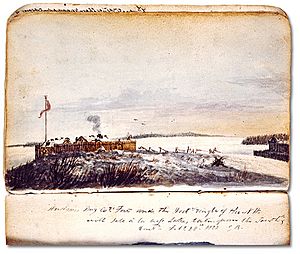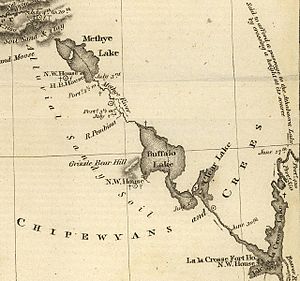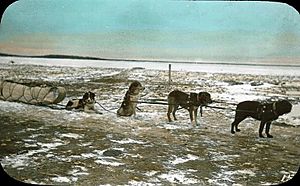Île-à-la-Crosse facts for kids
Quick facts for kids
Île-à-la-Crosse
ᓵᑭᑕᐚᕽ
sâkitawâhk |
|
|---|---|
|
Northern village
|
|

Forts of Île-à-la-Crosse by George Back in 1820
|
|
| Country | Canada |
| Province | Saskatchewan |
| District | Northern Saskatchewan Administration District |
| First Trading Post | 1776 |
| Mission founded | 1846 |
| Day School founded | 1847 |
| Boarding School founded | 1860 |
| Government | |
| • Type | Municipal |
| Area | |
| • Total | 23.84 km2 (9.20 sq mi) |
| Population
(2016)
|
|
| • Total | 1,296 |
| Metis settlement | |
| Time zone | UTC−06:00 (CST) |
| Postal code |
S0M 1C0
|
| Area code(s) | 306 |
| Highways | Hwy 155, Hwy 908 |
| Waterways | Churchill River, Beaver River |
| Official name: Île-à-la-Crosse National Historic Site of Canada | |
| Designated: | 1954 |
Île-à-la-Crosse (Plains Cree: ᓵᑭᑕᐚᕽ, romanized: sâkitawâhk) is a small community in northwestern Saskatchewan, Canada. It is known as a northern village. This place was once a very important spot for trading posts, with the first one built in 1778. Île-à-la-Crosse is the second oldest community in Saskatchewan, after the Red River Colony which started in 1811.
The village is located on a long piece of land that sticks out into Lac Île-à-la-Crosse. It is connected to other lakes and rivers, like Peter Pond Lake and Churchill Lake. These waterways were like old highways for travel.
The Cree and Dene peoples, who used these water routes, called the area Sakitawak. In the Cree language, this name means “big opening where the waters meet.” This area is special because it's on a continental divide. This means some waters flow north to the Arctic Ocean, and others flow east to Hudson Bay. Île-à-la-Crosse was a key spot for trade because it was easy to reach other trading posts further north. This also made it interesting for Catholic missionaries and fur trading companies.
Contents
A Look Back: The History of Île-à-la-Crosse

The area around Sakitawak was a meeting point for the Cree and Dene peoples. Because of its location at the start of the English River District, it became a busy place. People from different cultures came together here. This included the Cree, Dene, Scots, English, French, and Métis peoples. They shared their cultures and traded goods.
The Fur Trade Era
The fur trade greatly shaped Île-à-la-Crosse. It led to families and businesses forming between Indigenous people and European traders. This helped create a unique Métis community in northern Saskatchewan. As traders moved north and west, Île-à-la-Crosse became a central place. It was a hub for organizing the trade of furs and other goods from the Northern Plains to the rest of the world.
First Trading Posts
In 1775, a man named Thomas Frobisher explored the area. He saw that Île-à-la-Crosse was a great spot to reach routes further north and east. In the winter of 1776, he built the first trading post there. The next year, Thomas and Joseph Frobisher asked Peter Pond to map a route from the post to Athabasca. Pond's route became very important for traders for many years. The area was even called the English River District because Thomas Frobisher was the first English speaker there.
Frobisher's success caught the eye of other traders from Montreal. These traders later joined with the Frobisher brothers to form the North West Company in 1783. The North West Company then hired Patrick Small to manage the post all year round. This showed how important Île-à-la-Crosse was for managing trade in the larger district.
In 1785, another trading post was built by a group from Montreal, led by Alexander Mackenzie. There was a lot of competition between these companies. This led to disagreements over who controlled the valuable resources. The Hudson's Bay Company also arrived later, adding to the competition. They finally set up their own post in 1791. The North West Company remained powerful until it joined with the Hudson's Bay Company in 1821.
The English River District
After the two companies merged in 1821, the trading post at Île-à-la-Crosse became the main office for the English River District. It was in charge of making sure other smaller posts had supplies. It also kept the northern and southern trade routes open. Being a central hub meant it was a contact point for all the trading posts. This also attracted the attention of missionaries.
The area became a special home for the Métis people. This was because many children were born from relationships between Cree and Dene women and the fur traders. Records kept by officials showed how the Métis population grew. This helped tell the story of the Métis in northwest Saskatchewan, different from those in the Red River Colony.
After the main office was set up, the Hudson's Bay Company tried to reduce the number of people working there. They wanted to lessen their responsibility to support the families of traders. But this effort didn't work, and the Métis community continued to grow. By 1856, the English River District included posts in many places. However, many of these posts later closed due to new settlers and changes in the buffalo migration.
Catholic Missionaries Arrive
In 1845, a leader named Roderick McKenzie asked Bishop Joseph-Norbert Provencher to start a mission in Île-à-la-Crosse. Another person, Jean-Baptiste Thibault, also wrote to the Bishop. He felt it was urgent to send missionaries because the Métis people were eager to learn about Catholicism.
At first, the Hudson's Bay Company controlled the region outside the Red River Colony. They managed all the transportation routes to their trading posts. This allowed them to limit missionary activities to the Red River Colony. But later, the governor of the Hudson's Bay Company, George Simpson, allowed missionaries to enter the North-Western Territory. This opened the door for Catholic missions to spread.
The Saint-Jean-Baptiste Mission
In 1845, the Oblate General Administration agreed to set up a mission in Île-à-la-Crosse. Fathers Alexandre-Antonin Taché and Louis-François Richer Laflèche were chosen to start it. They arrived in September 1846. They used an old cabin left by the North West Company. They began holding church services the next spring. This cabin served as both a place to live and a mission.
Later, in 1848, another Oblate, Henri Faraud, helped fix up the cabin. The main goal of the Saint-Jean-Baptiste Mission was to help start other smaller missions. Father Taché traveled a lot to places like Green Lake and Portage La Loche to do this.
The missions needed their own money, separate from what was paid to Bishop Provencher. This made the Saint-Jean-Baptiste Mission the main administrative center for all the missions in the North-West Territory. Alexandre-Antonin Taché became the first Oblate leader for the area. More Oblates were sent to help with the growing work. They also got help from lay brothers, who built a home for the missionaries. The Oblates also asked the Grey Nuns (Sisters of Charity of Montreal) for help. The Grey Nuns helped run the mission and provided resources to other missions.
By 1860, Saint-Jean-Baptiste became a supply center. It sent food, clothing, and other items to nearby posts. It also became a transfer point for goods and religious items coming from the Red River Colony. This helped communication with distant missions in the North. However, fires and other problems hit the mission in 1867. This caused it to lose many resources and made it harder to do its administrative duties.
Le Couvent Saint-Bruno
The Sisters of Charity of Montreal, also known as the Grey Nuns, arrived in Île-à-la-Crosse on October 4, 1860. Three sisters came to help, including Sister Agnès, Sister Philomène Boucher, and Sister Pepin. A few days after they arrived, the convent was named Saint Bruno Convent.
The mission had started a day school in 1847. But attendance was poor. So, the Grey Nuns were asked to start a boarding school. On November 25, 1860, the Sisters of Charity opened the boarding school inside the Saint Bruno Convent. It provided both education and medical care.
A fire destroyed the building on March 1, 1867. Everything had to be rebuilt. In 1874, a new school building was constructed and named Notre-Dame du Sacré Cœur. The Sisters of Charity later moved away for a while. They returned in 1917 to open another school called the School of the Holy Family.
People of Île-à-la-Crosse: Demographics
In the 2021 Census, Île-à-la-Crosse had a population of 1,425 people. They lived in 445 homes. This was a small increase from its 2016 population of 1,296. The area of the village is about 23.3 square kilometers.
In the 2016 census, most residents identified as Métis peoples (77%). Another 18% identified as First Nations. Most residents (98.4%) speak only English. About 18% speak Indigenous languages, mainly Algonquian languages. About 7.4% speak Michif.
Because the village is in a remote area, the number of people living there can change with the seasons. Many people leave the community for work. So, it's helpful to look at the number of homes that are usually lived in. These numbers were 406 in 2016, 425 in 2011, and 408 in 2006.
| Canada census – Île-à-la-Crosse community profile | |||
|---|---|---|---|
| 2016 | 2011 | 2006 | |
| Population: | 1,296 (-5.1% from 2011) | 1,365 (+1.8% from 2006) | 1,341 (+5.8% from 2001) |
| Land area: | 23.84 km2 (9.20 sq mi) | 23.84 km2 (9.20 sq mi) | 23.84 km2 (9.20 sq mi) |
| Population density: | 54.4/km2 (141/sq mi) | 57.3/km2 (148/sq mi) | 56.2/km2 (146/sq mi) |
| Median age: | 29.0 (M: 28.2, F: 29.9) | 27.4 (M: 26.9, F: 27.9) | 24.7 (M: 22.7, F: 27.2) |
| Total private dwellings: | 450 | 443 | 485 |
| Median household income: | $63,232 | $42,073 | |
| References: 2016 2011 2006 earlier | |||
Language Spoken in Île-à-la-Crosse
Northern Michif Language
The language spoken by people from Île-à-la-Crosse is special. It comes mostly from Plains Cree, with some words borrowed from mission and Métis French. It's not a perfectly mixed language. Instead, the Michif dialect spoken here relies heavily on its Plains Cree roots. This is because many people knew Cree better than French. This language developed to help people communicate between Île-à-la-Crosse, Green Lake, and Buffalo Narrows.
In the past, this language was just called Cree. But in recent years, it has been recognized as a type of Michif. Today, people who speak Northern Michif sometimes use English words instead of French ones. This is because most people in the area now speak English.
Education in Île-à-la-Crosse
Boarding School History (1860–1972)
The boarding school, run by the Sisters of Charity, started with 9 girls and 6 boys in 1860. The number of students slowly grew over the years. In the early years, there were concerns that children were not learning English well. They kept speaking the Cree language. The school also had problems with health issues and not enough food. The Oblates blamed this on a lack of government funding. After a fire in 1867, the boys' dormitory burned down, and the school closed until 1874.
Parents were worried about how children were treated. However, Sara Riel, a Grey Nun at the school, felt parents didn't appreciate the teaching. English lessons were stopped in 1876. The school moved temporarily to the Beauval Indian Residential School. But it returned in 1917, and the Grey Nuns renamed it the School of the Holy Family. More fires happened in 1920 and 1921, but teaching continued. By 1929, 42 students were enrolled.
In 1944, a report on education in northern Saskatchewan suggested changes. It called for more day schools and two new large boarding schools. These ideas didn't happen. However, the Sisters of Charity did open a school in a bigger building by 1946. More fires in 1964 and 1972 finally led to the closing of the church-run schools. They were replaced by the current public schools.
Modern Schools (1972–Present)
Today, Île-à-la-Crosse has two schools. Rossignol Elementary Community School serves students from Pre-Kindergarten to Grade 6. It was designed by the famous architect Douglas Cardinal. Rossignol High School teaches Grades 7-12. This high school is part of the Île-à-la-Crosse Integrated Services Centre. This large building also has a hospital, a daycare, care for seniors, and offices. Both schools are part of the Île-à-la-Crosse School Division No. 112.



